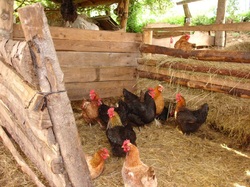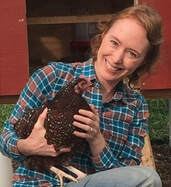
What does "free range" even mean, anyway? Are the chickens gallivanting about in a glorious pasture full of grass and tasty bugs, or are they just "free" to roam a fenced-in concrete slab?
That is in the question, indeed, and in today's post, I will address this, and the multitude of often confusing labels you see on store-bought eggs, to help you understand the difference in the quality of the eggs, as well as the quality of life their feathered progenitors enjoy.
However, I recently found an excellent article which explained the different labels as clearly as any I have ever seen, so if you want the full scoop, you can check out the article via the link below. But if you're just looking for a quick run-down, I will summarize it for you here.
Here are the most common labels you may see on eggs, and what they really mean:
"All Natural": This label basically means nothing, as eggs are inherently a natural, whole food. In fact, they are as close to "unprocessed" as any animal food product you can find in the store! So this term is, as the article says, really just "a marketing ploy."
"Antibiotic - Free:" While it may be true, as with "All Natural", this label doesn't really mean that much, since most egg-laying chickens in the U.S. are not given antibiotics. (Meat chickens are, however, so if you're buying the chicken instead of the egg, this is something you might want to look out for.)
"Hormone-Free": Again, this is another marketing tactic. Hormones are not fed to egg-laying chickens in the U.S. anyway, so this term technically applies to all eggs.
 Free-range chickens only have to have
Free-range chickens only have to have access to the outdoors.
"Cage-Free": While this may sound like a good thing in theory, in reality it probably doesn't mean what you think it does in terms of the chickens having a better life. In fact, some studies have shown that cage-free chickens actually have higher mortality than those in smaller cages. After all, cage-free doesn't really mean the chickens have more space - it just means they aren't individually enclosed. They are still crammed with thousands of other chickens into a huge warehouse, where they often barely have room to move at all, and may sometimes attack and cannibalize each other.
"Certified Humane": Now we're getting somewhere, as these chickens are not confined to cages, and they must be allowed space to roam and interact naturally. However, beak cutting is still allowed, and the chickens aren't necessarily outside in a natural environment eating their natural diet of bugs, worms, and grass.
"Vegetarian-Fed": Okay, this sounds good, right? After all, some of us health-concerned citizens have read about confined animals being fed animal byproducts in their feed - yuck! But not so fast....
If you know chickens, you also know that chickens love to eat bugs, worms, slugs, grasshoppers, etc.. While yes, they also love fruits and vegetables, a chicken's natural diet does include protein from animal sources, so a vegetarian diet for a chicken is actually not very natural at all. Not to mention, if they are labeled as "vegetarian," that means that chicken probably didn't spend any time outdoors (where they could potentially eat non-vegetarian foods).
"Free Range" or "Free-Roaming": Here we have one of the most commonly used - and misunderstood - labels. What this label means is simply that the chickens must have some "access" to the outdoors, even if the outdoor area is just a slab of concrete or a fenced in area of bare dirt. And while you might think free range means roaming free wherever they want, actually the minimum space required to be considered "free range" is only 2 square feet per chicken! That doesn't sound very free to me....
"Organic": In order to carry the "organic" label, these chickens must be fed only certified organic feed, and must be "free range." However, the chickens who lay organic eggs can still be mistreated (beak cutting, forced molting, etc.) and may live in a small, crowded, and unhealthy environment.
 Chickens on pasture.
Chickens on pasture. These are the chickens you see on the carton, roaming the green grass, catching bugs, and living a natural chicken life. As the article says, "If you are at all concerned about the happiness and welfare of the chickens laying the eggs you eat, then this is what you want to read on the carton."
So there you have it! Next time you're shopping for eggs, now you'll have a better idea of what you're looking at - and where the eggs you're eating came from.
For more detail, plus some info on the practices of beak cutting and forced molting, see the full article here at FreshEggsDaily.com.
To your health (and the health of the food you eat),
Rose.



 RSS Feed
RSS Feed